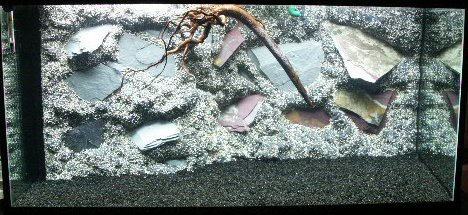
My Fishtank
It's a 20 year old 200 liter (53 gallon), 100x40x50cm fishtank, made from 8mm glass, that I completely refurbished:
The decor has been made from several sorts of rocks, glued with silicone glue and pieces of glass to the the background glass.
The surrounding space is then filled with polyurethan foam (what a mess this foam!).
After a couple of years (I had other things to do...) the foam was completely hardened.
I painted the foam in different nuances of gray with oilpaint and after drying I applied three layers of liquid poyester for protection.
Before the polyester layer dried I dredged some gravel of different granularities onto it.
The filter compartiment is made from some partitions of glass and measures about 38x9cm over the complete height of the tank.
Between fishtank and filter I glued a black perfored PVC grill as separation.
I increased the height of the tank with a 8mm thick, 10cm high PVC chassis, glued onto the glass walls. This way I was able to incorporate the lighting system without loosing any volume.
The outside of the tank is finished with black PVC panels of 3mm thick and PVC L-profiles.
Accessories:
Sicce Nova 800l/h pump for the filter (integrated filtercompartiment in fishtank)
2x TLD30 Lamps: 1 Osram Biolux in front, 1 Osram Lumilux 11/860 in the back (about 10 hours of lighting per day)
Velleman kit 4-output microprocessor timer & clock for the lamps
Sera 500g CO2 tank with detention valve and manometer
Sera PH controller with electromagnetic valve
Sera CO2 bubble counter
Sera continuous CO2 monitor with indicator liquid in fishtank
External Do-It-Yourself CO2 reactor
Sicce Micra 400l/h pump for the CO2 reactor water circulation
Velleman electronic LCD thermometer & thermostat kit
Rena 200W Heater
Very busy building a PIC16F876 based controller with LCD, timer & dimmer outputs for controlling fluorescent dimmable electronic ballasts (sunrise & sunset simulation)...
______________________________
The actual fish population:
- 3 couples of Phenocogrammus Interruptus (Congo Tetra)
- 6 Gymnocorimbus Ternetzi (Black Tetra) (7 years old)
- about 15 Cheirodon Axelrodi (Cardinalis - several of them are now 7 years old)
- 3 Rasbora Hengeli
- 3 Crossocheilus Siamensis
- 3 Hemigrammus Rhodostomus (Red nose)
- 2 Acantophtalmus Kuhli (7 years old)
- 1 Synodontis Nigriventris
- 3 Danio Rerio
- 3 Hyphessobrycon Herbertaxelrodi (Black Neon)
- 1 Corydoras Sterbai
- 1 Melanotaenia Praecox (Rainbowfish)
- 2 fresh water shrimps
I would like to add some Pterophyllums Scalare (Angelfish) but plants are growing so quickly that is not much room left for Angelfish.

5th of November, 2001 - 1st day: Tank filled with tapwater (130 liter netto). Filtering, lighting and heating fully operational.
The root on the water surface is still floating (after having it cooked for hours!)
Normally it should sink to the bottom after a couple of days.
PH=8 - GH=12° - KH=10°
I used (about 20kg) of black gravel because of the beautifull contrast with the decor (and the green color of the future plants).
Underneath the gravel I applied a layer of granular fertilizer.
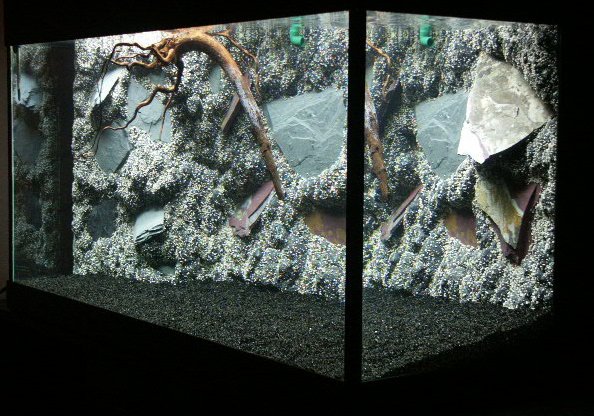
10th of November, 2001: PH is decresing (7.5), GH is increasing (15°).
NO3 is 0.5mg/Liter, increasing. Biofilter mass is still not colonised with bacteries.
Click on the picture for hi-res image (700Kb)
25th of November, 2001: Changed 60 liter of demineralised H2O, added plants, installed Sera CO2 kit .
I tried the "yeast method" in Coke bottles for obtaining CO2 but it'is quite cumbersome and difficult to control.
PH=7.5 - KH=7° - GH=10° - NO3=0.1mg/Liter (filter mass is beginning to colonise).
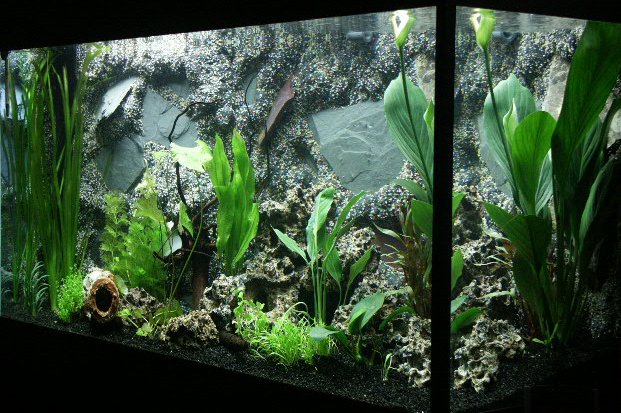
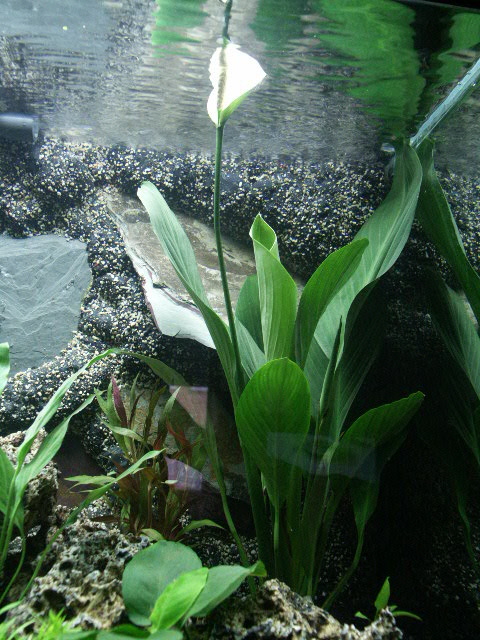
One of my plants is in blossom... Beautifull!
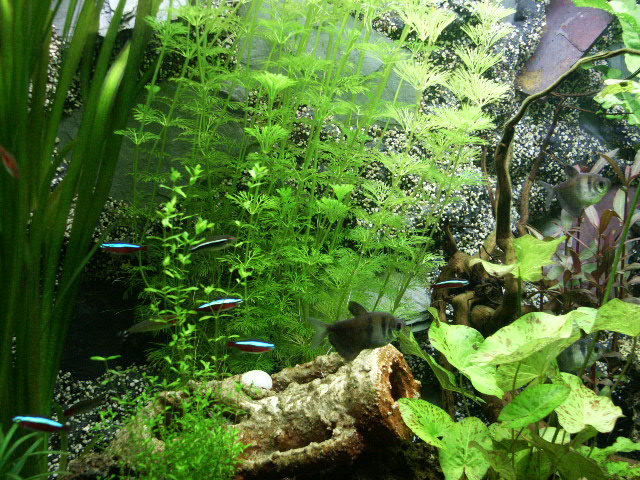
As you can see, plants begin to grow quickly (thanks to the CO2).
The fishes of my old 100 liter fishtank are very happy in their new environment. (I had no losses...)
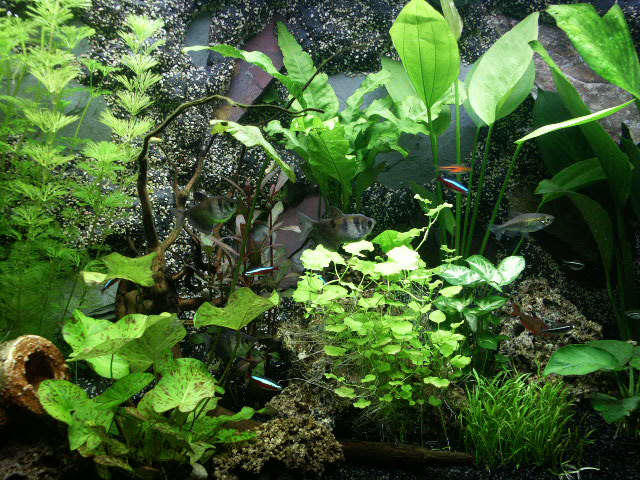
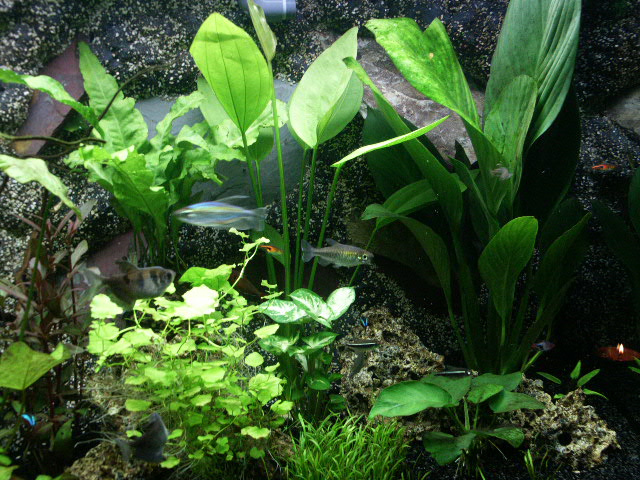
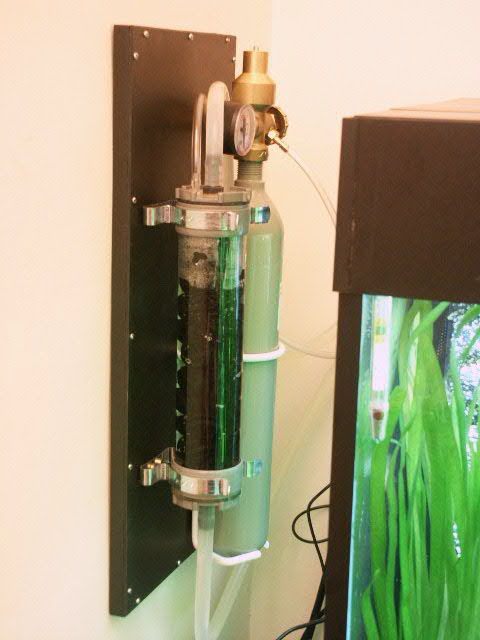
The Sera CO2 tank and DIY CO2 reactor. I use about 1 filling (500g) of CO2 every 2 months.
People knowing my airtrap construction for my watercooled PC will recognise it in this CO2 reactor...
In fact it IS the same construction (just a little longer) with upper H2O input PVC barb (3/8") and 5mm CO2 input, and lower H2O output barb.
The reactor tube is filled with mini-bioballs (expensive!!) for a better contact between H2O and CO2.
Also clearly visible is the level of H2O and CO in the tube.
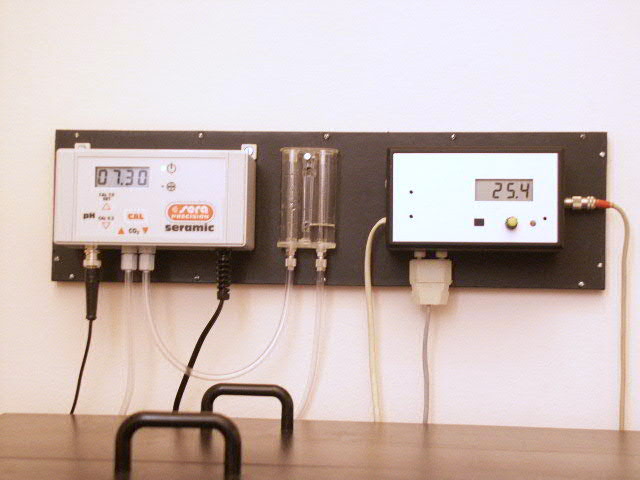
Sera PH controller, bubble counter and DIY Thermometer/Thermostat.
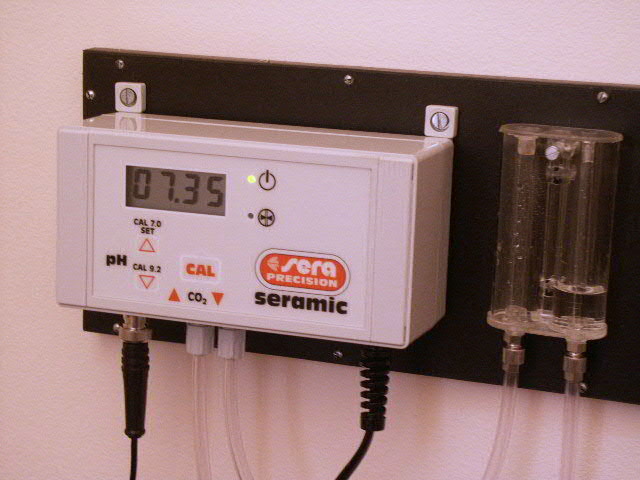
Close-up of the Sera PH-meter & CO2 controller.
You can clearly see the PH-sensor BNC connector on the left, input hose from the CO2 tank to the valve and output to the bubble counter.
Actually the PH value is regulated between 6.95 and 7.05
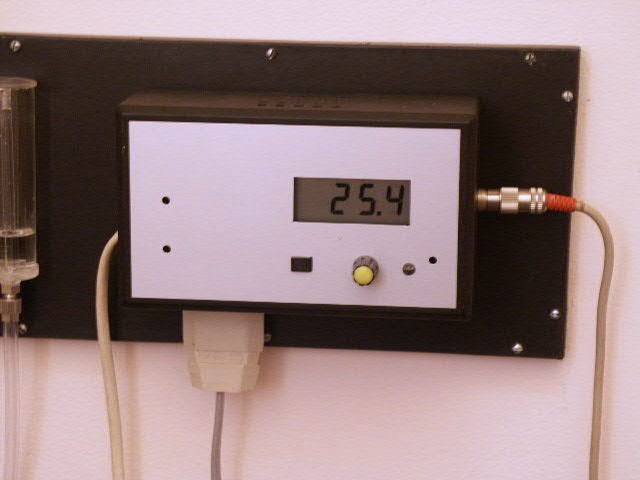
Close-up of the DIY Velleman LCD thermometer/thermostat
The cable on the lower side goes to the Rena heater, the right cable goes to the KTY10 temperature sensor in the last filter compartiment.
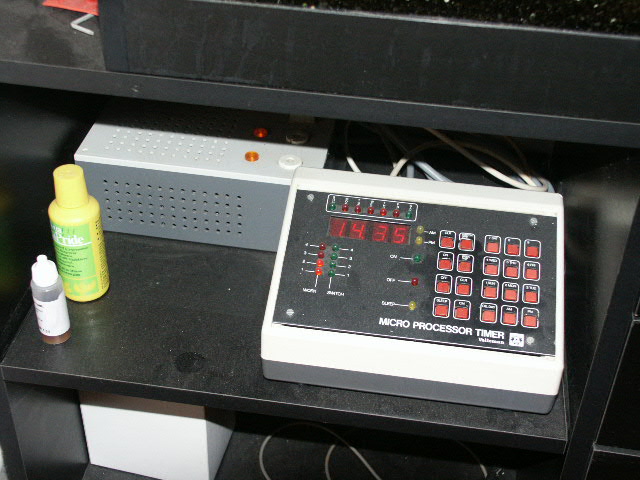
Velleman Timer (only 2 from the 4 outputs are used) and in the back the box with the ballast & starters for the lamps.
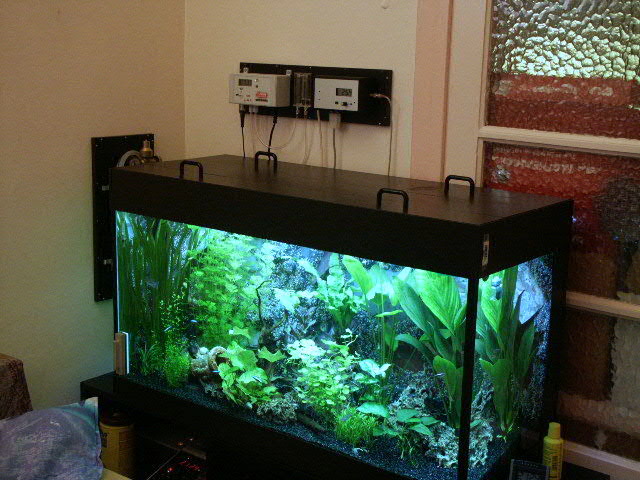
General view of my fishtank after 2 months.
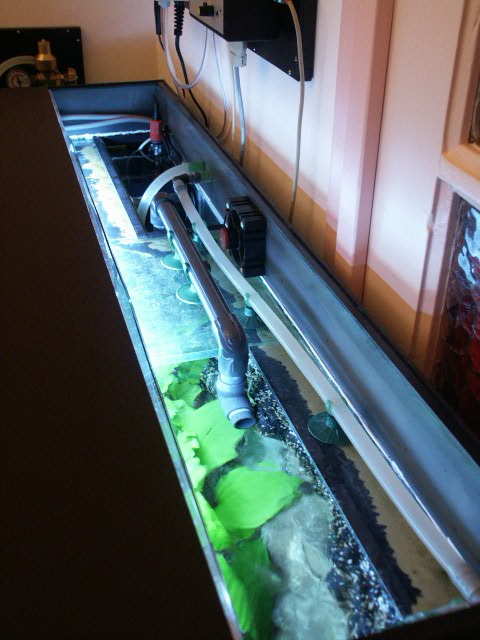
Detail of the filter compartiment (in the back) with the PH-sonde and the heater in the 1st compartiment, filter substrates in the 2nd, pumps and temperature sensor in the 3rd, PVC return line of the filtered water and silicone return hose from the CO2 reactor to the fishtank.
Also visible is a 5V fan, powered on 3.5V, for air circulation under the fishtank covers, but I have to much water evaporation when it runs so I don't use it anymore.
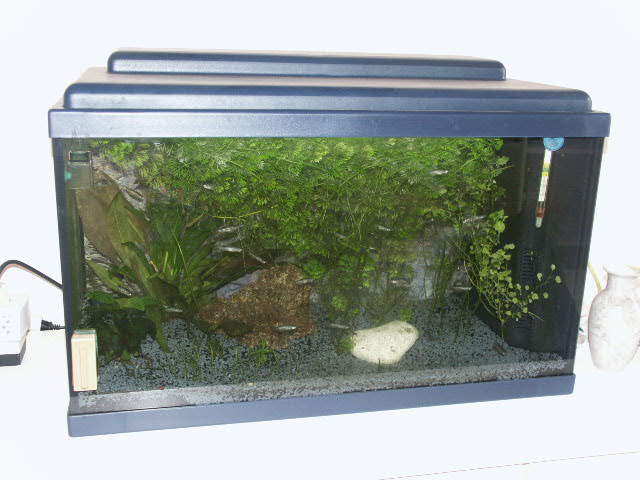
My second fishtank, a litlle Riga 45 liter (60x35x25cm) with breeded guppies (about 10) and breeded Danio Rerio's (about 40!).
I'm still using the "yeast method" on this fishtank to obtain CO2.
The used CO2 reactor is the Sera reactor that was included in the Sera CO2 kit.
A part of the returning waterflow from the pump is going to the reactor through a 3-way valve.
In the left upper corner you can see a Sera continuous CO2 monitor:
Yellow = too much CO2.
Green = OK
Dark green = too less CO2
Actual situation:
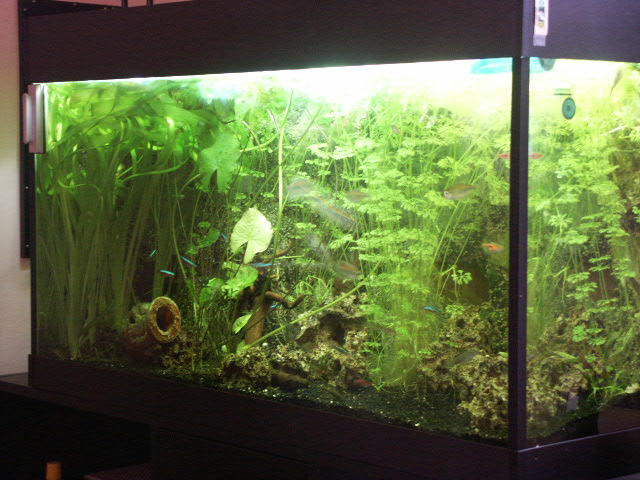
Since I don't have much time left with the company, my fishtanks are a litlle overgrown...and I have to thin out most of the plants.
It was quite difficult to take this picture with ambient light because the light of the two 30W lamps has difficulties to penetrate the layer of plants on the surface.
Water quality is giving me some headaches: GH and KH are way too high....time for a big water change.